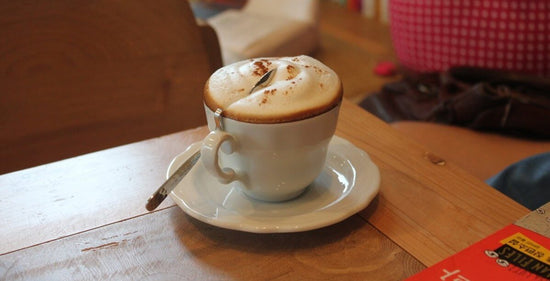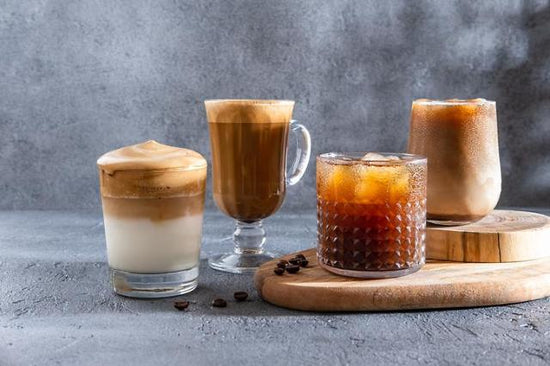South Korea: A Brewing Hotspot For Coffee Lovers Pt.1

When you think of South Korea, your mind might immediately drift to K-Pop, Korean Dramas, Beauty Routine, or the buzzing city life of Seoul. But there's another aspect of Korean culture that's been brewing and is now ready to be served. Beneath the towering skyscrapers and the mazy alleyways, it also boasts a thriving cafe culture.
Coffee has become really popular in Korea in the last few years. Its story shows how well the country can mix old and new ideas. Coffee went from just an emperor's drink to a big part of a culture that's known all over the world.
In this post, immerse yourself in the strong aroma of Korean coffee and discover why cafes have become a culture in this fascinating country.

Why Cafes are a Cultural Phenomenon in Korea
South Korea is known for its fast-paced city lifestyle, where people often find themselves plunged into demanding work schedules and stressful daily routines, so cafes have become escape places from hectic city life.

Cafes are central gathering places for friends, families, and couples to bond, converse, and spend quality time together. They serve as a comfortable, neutral ground for both socializing and solitary reflection.
While serving traditional Korean teas and snacks, Korean cafes also offer a wide range of international coffee beverages and desserts. This fusion resonates with Korean consumers who value their heritage and global trends.
Apart from this, many cafes in South Korea provide free Wi-Fi and ample electrical outlets, making them ideal locations for remote work, study, or group meetings. This practicality has made cafes an extension of people's workplaces and study spaces.
History of Coffee in Korea
South Korea's love for coffee is both a cultural phenomenon and a booming industry. In fact, the country consumes an impressive 138,960 tons of coffee every year, making them among the largest coffee consumers in the world. It means that, on average, each Korean enjoys about 512 cups of coffee per year–that's more than one cup a day, every day!
But how did such a lifestyle start? When did coffee first become a part of Korean culture?

Coffee was introduced to Korea much later than it was to Europe. Despite its late introduction, coffee has grown in popularity over the past few decades. While coffee consumption required official national approval in countries including Italy, France, and the United Kingdom, the drink found instant embrace within the Korean market.
The history of coffee in Korea began during the reign of Emperor Gojong (1863-1907), specifically in 1896, when he tasted coffee for the first time. This happened while he was taking refuge in the Russian Embassy after his wife, Empress Myeongseong, was assassinated. Here, Antoinette Sontag, related by marriage to the Russian consul general, introduced him to coffee.
In 1902, with the emperor's support, Antoinette opened the first Korean coffee shop, a Dabang, primarily for foreign diplomats. The coffee culture in Korea significantly developed during the Japanese occupation from 1910 to 1945, as more Dabangs were established, making coffee a local favorite rather than just a luxury drink.
Today, cafes have emerged as popular hubs for diverse people, ranging from students and professionals to international visitors. These venues serve as places to enjoy a cup of coffee and as spaces for social interaction, study, work, and cultural exchange.
Types Of Cafes in Korea
Korea hosts plenty of themed cafes, each with its unique concept. There are just endless exciting cafe scenes to discover. Below are some of the most popular types you can check out in South Korea:
Pet-Friendly Cafes
Pet-friendly cafes are a unique and delightful concept found in Korea, where cafes open their doors not just to humans but also to their furry friends. These cafes have become popular spots for animal lovers to enjoy a cup of coffee while spending quality time with their pets or interacting with the cafe's resident animals.

Board Game Cafes
Board game cafes offer an extensive collection of board and card games patrons can play while sipping coffee. It's a fun and exciting way to enjoy this beverage with your friends, family, or workmates.

Book Cafes
Book cafes in Korea are uniquely designed spaces that seamlessly blend the tranquility of a library with the warm ambiance of a cafe. These establishments cater to book lovers who enjoy immersing themselves in a good read over a cup of coffee or tea.

Art Gallery Cafes
If you're looking for vibrant and creative places that blend the aesthetic appeal of an art gallery with the cozy ambiance of a cafe, then Art Gallery Cafes are for you! These spaces invite visitors to appreciate, create, and immerse themselves in art while savoring a cup of coffee.

Plant Cafes
Plant cafes, sometimes called greenhouse cafes, have become popular in Seoul, Korea. These coffeeshops are not only Instagram-worthy attractions with their lush greenery, but they also provide a serene and natural environment for people to relax and enjoy their coffee.

Rooftop Cafes
Rooftop cafes offer seating with panoramic views of the city. These cafes provide open outdoor spaces where visitors can bask in the sunshine and enjoy a warm breeze, especially when they want to rest from the hustle and bustle in the big city.

Coffee Prices in South Korea
Recently, coffee prices in South Korea have ranged from 11,986.00 to 19,986.67 Korean Won (KRW) per kilogram, or 5,436.13 to 9,064.25 KRW per pound. This is the typical retail price (roughly $4.45) you can expect to pay for coffee in both Seoul and Busan.
When it comes to the cost of a cup of coffee at a cafe, prices can vary greatly. The exact price you'll pay depends on several factors, including the location, the type of coffee you order, and the reputation of the coffee shop itself.

For instance, a standard cup of coffee, such as a latte or cappuccino, can cost between 4,000.00 to 6,000.00 KRW (roughly $3.00 to $4.45). When it comes to instant coffees, it's usually more affordable as a typical jar (100-200g) may cost 1,500.00 to 2,000.00 KRW (about $1.00 to $2.00).
In simpler terms, more popular coffee shops in high-end locations may charge more for their coffee, while lesser-known cafes in less busy areas might have lower prices.
Boasting around 100,000 coffee shops, Korea has claimed the nickname "The Republic of Coffee." These establishments have evolved into more than just quick-stop beverage shops; they're social hubs fostering community and culture.
The heart of Korea's coffee scene pulses with innovation as trends like Dalgona coffee, fruit-infused brews, and vibrant lattes gain significant popularity. These creative concoctions have reached major social media platforms, captivating coffee lovers worldwide.
So, if you're a seasoned coffee connoisseur or a casual sipper, the diverse and dynamic Korean coffee culture is worth exploring. So, don't wait - begin your coffee journey today, discover unique flavors, and celebrate this beloved beverage in Korea.
What makes Korean Cafes unique?
Central to the country's social life, Korean cafes are known for their innovative themes extending beyond coffee service. Given the small size of most apartments, these cafes serve as preferred spaces for friends to gather.
How popular is coffee in South Korea?
South Koreans have a high coffee consumption rate, averaging about two to three cups daily. This trend is primarily attributed to the country's work culture and the convenience of nearly 100,000 coffee shops nationwide. South Koreans' most popular coffee types are instant coffee and coffee products in pods and capsules.
How big is the coffee market in Korea?
From 2017 to 2021, the coffee market in South Korea blossomed into an impressive industry worth around $11.36 billion. This growth is fueled by the dynamic and evolving coffee and tea capsules market, where extensive research and development activities have sparked a wave of exciting innovations. These advancements have not only enriched the variety and quality of products available but also contributed significantly to the market's robust growth.









Leave a comment